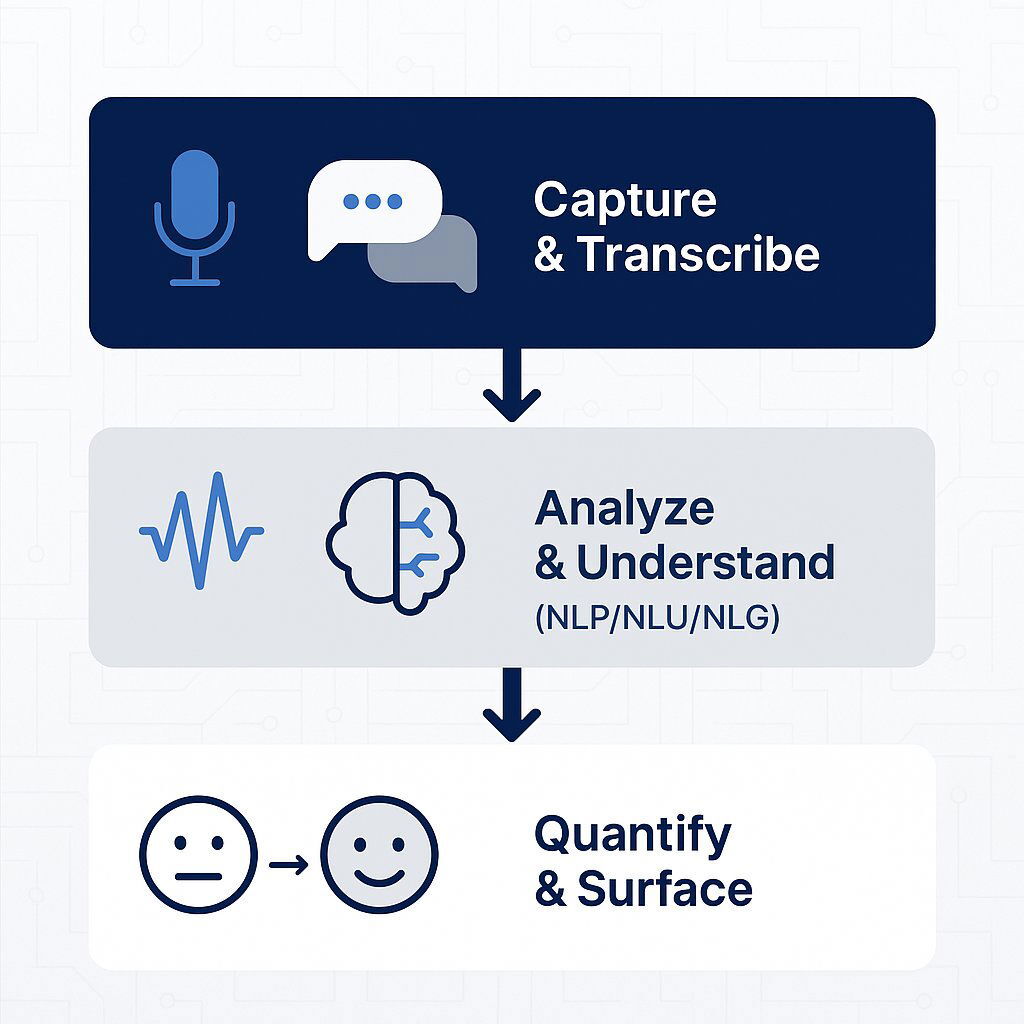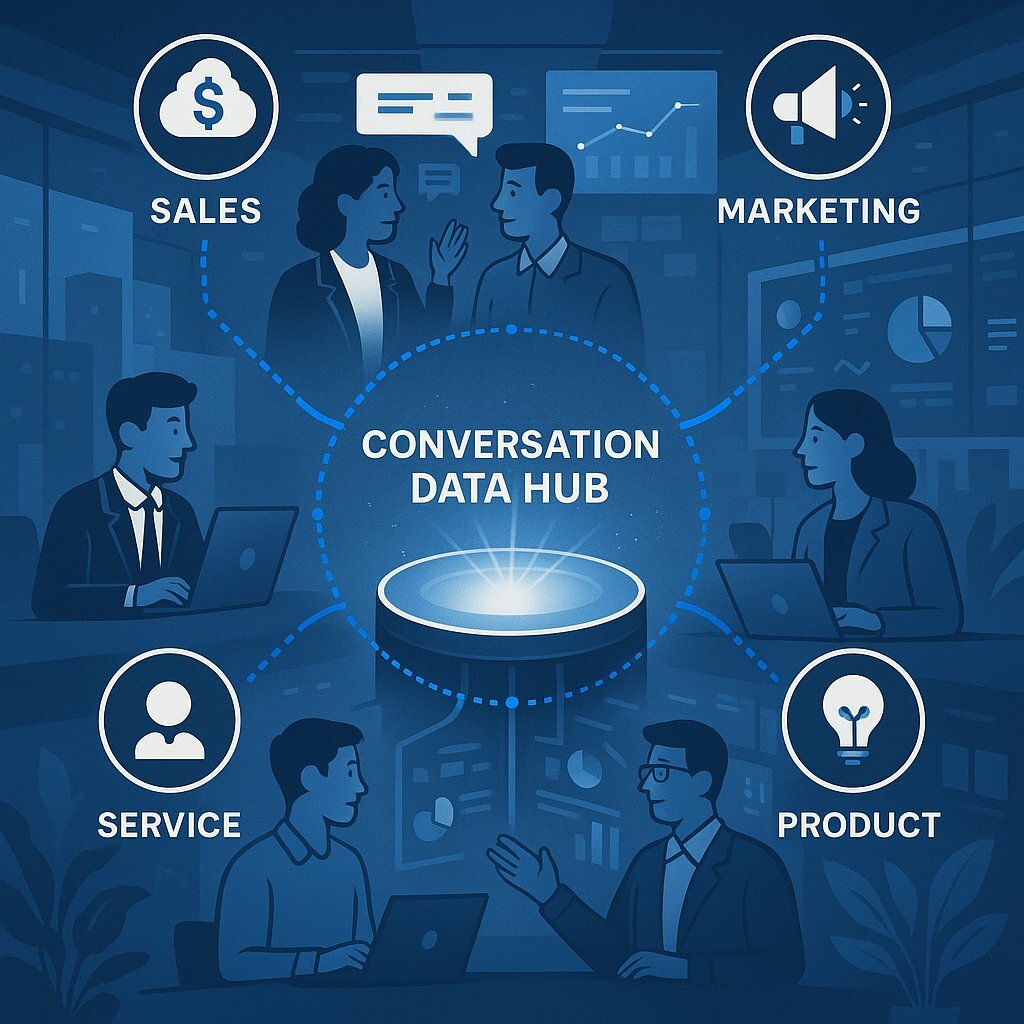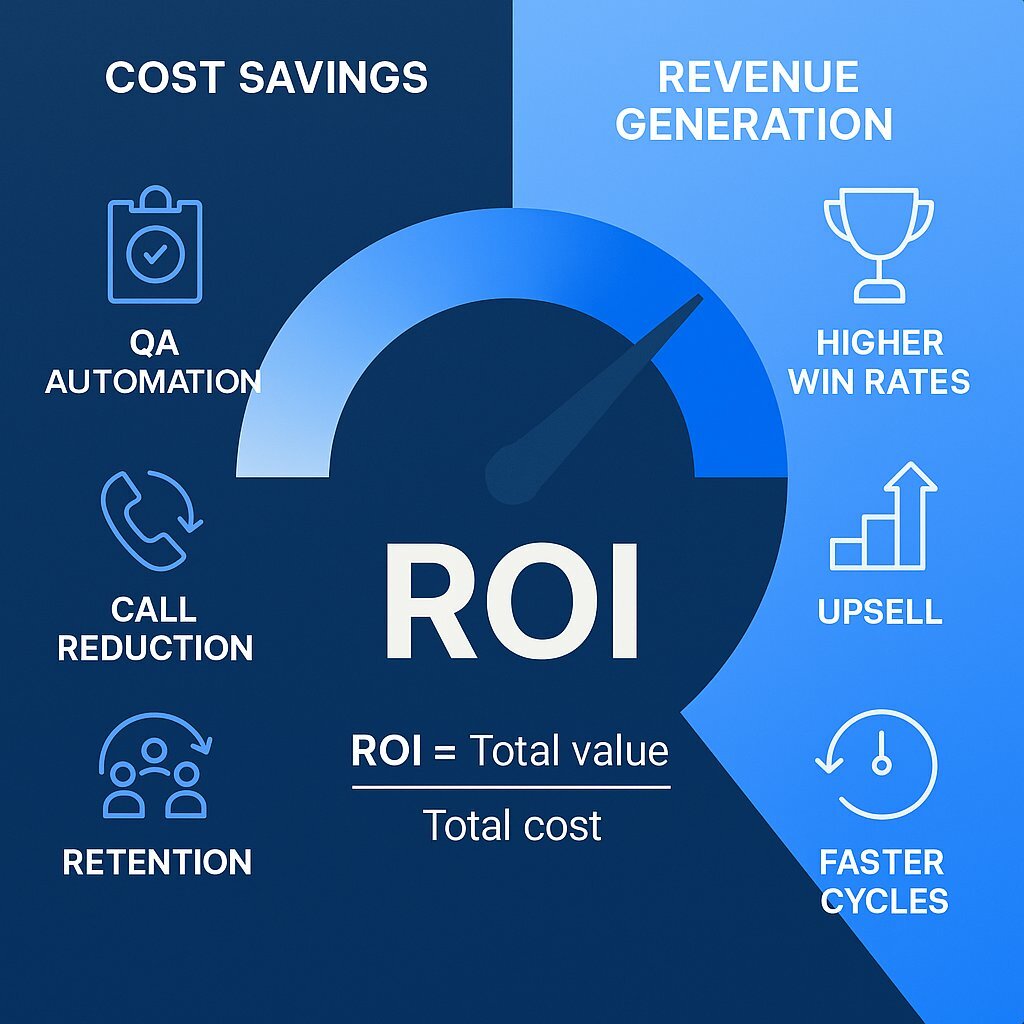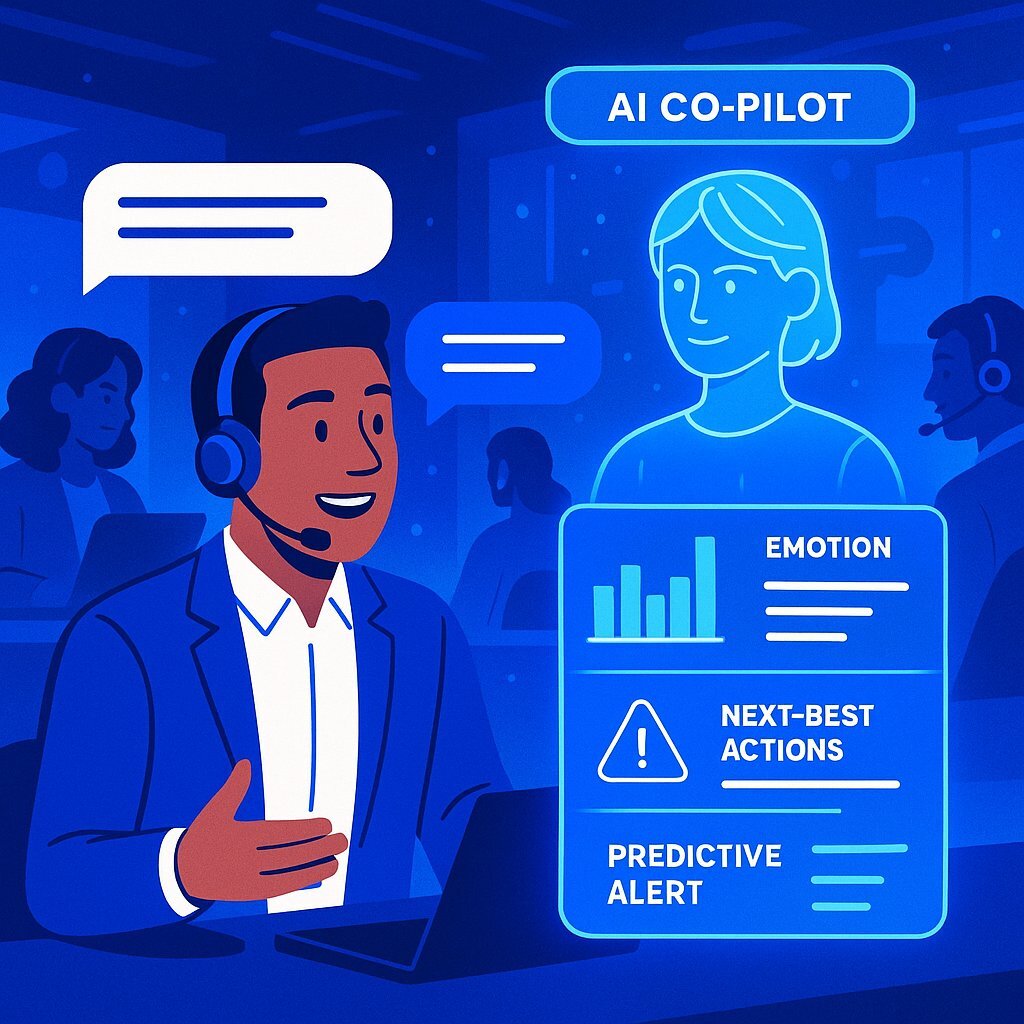
Conversation Intelligence in Enterprise: Unlock Customer Data & Drive Growth
November 11, 2025 / Bryan ReynoldsIntroduction: Your Customers Are Talking. Are You Truly Listening?
In the modern enterprise, customer conversations are the lifeblood of the business. Every day, across thousands of phone calls, video meetings, emails, and chat sessions, your customers are telling you exactly what they want, what frustrates them, and what it would take to win their loyalty. This constant stream of interaction is the most valuable, unfiltered source of business intelligence an organization possesses. Yet, for most companies, it remains a vast, untapped goldmine.
Research reveals a startling reality: over 90% of the strategic insights buried within these daily conversations disappear the moment the call ends. This data evaporates, leaving behind only a brief summary in a CRM note or a support ticket. This isn't just a missed opportunity; it's a critical strategic liability. Leaders are left managing by anecdote, relying on a sales forecast that "looked good in the CRM… until it disappeared". This data blindness has tangible consequences in a market where 61% of consumers will consider switching to a competitor after just one unresolved issue.
The solution to this challenge has arrived in the form of AI-powered Conversation Intelligence (CI). This transformative technology provides the tools to finally listen at scale, systematically capturing, transcribing, and analyzing 100% of customer interactions to extract actionable, data-driven insights. It moves organizations beyond guesswork and into a new era of predictive, customer-centric operations.
This report serves as a comprehensive playbook for leaders across the enterprise—specifically Heads of Sales, Customer Service, and Marketing. It provides a detailed examination of how to leverage Conversation Intelligence to transform raw dialogue into structured data that drives predictable revenue, enhances customer loyalty, and accelerates product innovation.
Section 1: Beyond Transcription: Understanding the Conversation Intelligence Engine

To harness the full strategic power of Conversation Intelligence, leaders must first understand what it is, the sophisticated technology that drives it, and why its emergence represents a fundamental shift in how businesses can operate and compete.
Defining Conversation Intelligence: The Analysis Layer
At its core, Conversation Intelligence is the process of using advanced AI-powered software to analyze vast quantities of speech and text data from customer-facing interactions to create insights that drive business action. It moves far beyond basic call recording and transcription, focusing on understanding the full context of a conversation—not just
what was said, but also how it was said and, most importantly, why it matters to the business.
A crucial distinction for executives is the difference between Conversation Intelligence and Conversational AI. These terms are often used interchangeably but represent fundamentally different functions.
- Conversational AI is the "interaction layer." These are the technologies, like chatbots and voice assistants, that actively participate in a conversation to simulate human interaction and automate tasks. For leaders focused on maximizing the power of Integrating AI, understanding this distinction can guide investments that support both engagement and deep analysis.
- Conversation Intelligence (CI) is the "analysis layer." It works in the background, 'listening' to or 'reading' human-to-human or human-to-bot conversations to extract strategic insights that can be used to improve business processes and customer experience.
In short, Conversational AI talks, while Conversation Intelligence listens and understands.
The Technology Stack: How AI Turns Talk into Actionable Data
The process by which CI platforms transform unstructured dialogue into strategic intelligence involves a sophisticated, multi-stage AI pipeline.
Step 1: Capture and Transcribe The process begins by capturing raw interaction data from every customer touchpoint, including voice calls, video meetings (like Zoom or Microsoft Teams), chat platforms, and emails. For voice and video, the audio is converted into text using a technology called Automatic Speech Recognition (ASR). The accuracy of this initial transcription is paramount to the entire process; as industry analysis notes, "If the words are wrong, the outcomes are too".
Step 2: Analyze and Understand This is the heart of the CI engine, powered by Natural Language Processing (NLP), a branch of artificial intelligence that enables computers to comprehend, generate, and manipulate human language. NLP is not a single process but a collection of techniques:
- Natural Language Understanding (NLU): This is how the AI "reads" the transcript to decipher meaning, context, and intent. It performs critical tasks like identifying key topics, recognizing named entities (such as competitor names, products, or people), and extracting key phrases like "I want to cancel my account" or "What is the price?".
- Natural Language Generation (NLG): This capability allows the AI to create human-like text outputs, such as automatically generating a concise summary of a 45-minute sales call or suggesting a next-best action for a service agent.
Step 3: Quantify and Surface Once the content is understood, the AI quantifies its emotional and qualitative aspects. Using Sentiment Analysis, the platform analyzes the words, tone, pitch variation, and even periods of silence to assign a sentiment score (e.g., positive, negative, neutral) to the interaction for both the customer and the agent. This structured data—topics, entities, sentiment, and other metrics like talk-to-listen ratios—is then aggregated and visualized in dashboards, trend reports, and real-time alerts for business leaders.

The Market Imperative: A Tectonic Shift in Business Intelligence
The adoption of Conversation Intelligence is no longer a niche trend; it is a mainstream strategic imperative. The global market for CI platforms is projected to experience explosive growth, expanding from an estimated USD 1.25 billion in 2024 to USD 12.02 billion by 2033, which represents a compound annual growth rate (CAGR) of 28.6%. This rapid expansion is not merely driven by a desire for more analytics but by the maturation of the underlying deep learning technologies that now make high-accuracy analysis possible at an enterprise scale. The market's maturity is further evidenced by the consistent recognition of leading vendors like Google, Cognigy, and boost.ai in influential industry reports such as the Gartner Magic Quadrant for Conversational AI Platforms.
This market acceleration is a direct consequence of a fundamental technological leap. For years, the promise of conversation analysis was hampered by the limitations of older AI models, which often produced inaccurate transcriptions and could only perform basic keyword spotting. The recent advent and commercial accessibility of Large Language Models (LLMs) and their underlying transformer-based neural networks have been the catalyst for CI's rise. These advanced models, trained on petabytes of data, have transformed rudimentary NLP into a "flexible interlocutor" capable of understanding nuance, sarcasm, and long-range context within a conversation. This technological breakthrough is what enables CI platforms to deliver on their core promise: deriving deep, meaningful insights at scale. Therefore, an investment in a modern CI platform is not an investment in a simple analytics tool; it is an investment in a new class of enterprise AI powered by the same engine driving the broader generative AI revolution.
Section 2: A Unified Source of Truth: Cross-Functional Impact of CI
The most profound impact of Conversation Intelligence is its ability to serve as a single source of truth for all customer-facing teams, breaking down the data silos that have traditionally separated Sales, Customer Service, and Marketing.

For the Head of Sales: Engineering a Predictable Revenue Engine
For sales organizations, CI marks a pivotal shift from managing by intuition to leading with data, transforming sales coaching from an art into a science.
- Clone Your Top Performers: Instead of shadowing a few calls and offering subjective feedback, sales managers can use CI to analyze 100% of their team's interactions. The platform identifies the specific questioning techniques, value propositions, and objection-handling talk tracks that are statistically correlated with closed-won deals. This allows managers to pinpoint what their top performers are doing differently and build a data-backed playbook to elevate the performance of the entire team.
- De-Risk the Pipeline in Real Time: CI functions as a powerful early warning system for deals at risk. It automatically flags critical moments in conversations, such as mentions of a key competitor, a sudden negative shift in customer sentiment, or a failure to discuss crucial topics like budget and implementation timelines. This enables managers to intervene proactively with targeted coaching or resources before a promising deal goes dark.
- Boost Rep Productivity and Focus: A significant portion of a sales representative's time—by some estimates up to 70%—is consumed by administrative tasks like taking notes and updating the CRM. CI automates these mundane activities by generating call summaries, identifying action items, and pushing key data directly to the CRM. This frees up reps to focus on high-value selling activities, with some organizations reporting a 50% increase in overall sales capacity.
- The Bottom-Line Impact: The results are tangible and significant. Studies have shown that sales teams effectively deploying Conversation Intelligence see an average overall revenue growth of 21% and achieve 15% higher sales win rates.
For the Head of Customer Service: From Cost Center to Insight Hub
Conversation Intelligence transforms the contact center from a reactive cost center into a proactive hub for strategic business insights and operational excellence. If you're addressing large-scale impacts—like mitigating bias in regulated industries—real-time conversation analysis is an invaluable tool.
- Achieve 100% Quality Assurance: The traditional practice of manually reviewing a small, random sample of calls for quality assurance (QA) is inefficient and provides an incomplete picture. CI automates this process, monitoring and scoring every single interaction for key criteria like script adherence, regulatory compliance statements, and expressions of empathy. This provides a comprehensive, unbiased view of service quality and compliance across the entire organization.
- Pinpoint Root Causes, Not Just Symptoms: Standard contact center metrics like Average Handle Time (AHT) measure efficiency but fail to explain why customers are calling in the first place. CI digs deeper, using topic modeling and sentiment analysis to identify the root causes of customer friction. By correlating negative sentiment with specific topics like "billing confusion" or "website navigation problems," leaders can identify and fix systemic issues, which in turn reduces overall call volume and improves First Contact Resolution (FCR). The financial impact can be substantial; one analysis by Medallia found that fixing a simple issue identified by CI, such as a broken confirmation email process, could save a typical enterprise $150,000 annually in avoided calls.
- Proactive Agent Coaching and Retention: CI helps create a culture of continuous improvement. It identifies recordings of agents who excel at de-escalating difficult situations or generating positive customer sentiment, creating a "best practice" library for training new hires. Critically, it can also serve as an early warning system for agent burnout. By detecting linguistic and acoustic cues of stress or frustration in an agent's voice, managers can provide targeted support and coaching before valuable employees decide to leave, directly combating costly agent attrition.
For the Chief Marketing Officer: Capturing the Authentic Voice of the Customer (VoC)
For marketing leaders, CI provides a direct, unmediated channel to the authentic voice of the customer, offering insights that are far more powerful than traditional market research methods.
Go Beyond Surveys and Focus Groups: Traditional VoC programs rely on solicited feedback, which is often provided by a small, non-representative sample of customers and can be influenced by the way questions are asked. CI captures the
unprompted VoC—the exact words, phrases, pain points, and objections customers use spontaneously in real-world conversations. This raw, authentic language is a goldmine for crafting marketing copy, website content, and value propositions that truly resonate with the target audience. Discovery-driven insights ensure your messaging is anchored in current, actual user needs and opportunities.
- Refine Messaging and Measure Real-World Resonance: Marketing teams invest heavily in developing key messages and value propositions, but it has historically been difficult to measure if those messages are actually being used by the sales team and how they land with customers. CI closes this feedback loop. It can track how frequently specific marketing-defined phrases are used in sales calls and analyze the customer's subsequent reaction and sentiment, providing a direct, data-driven way to optimize campaign messaging for maximum impact.
- Gain Real-Time Competitive and Market Intelligence: CI acts as a 24/7 competitive intelligence engine. It automatically identifies and surfaces every mention of a competitor in sales and service calls, providing unfiltered insights into their perceived strengths, weaknesses, pricing strategies, and marketing claims directly from the mouths of prospects and customers. Furthermore, it can identify emerging customer needs and market trends long before they surface in formal industry reports, giving the organization a critical first-mover advantage.
The ultimate strategic value of Conversation Intelligence extends beyond the optimization of any single department. It functions as the enterprise's central nervous system for customer truth. Historically, Sales, Service, and Marketing have operated with fragmented and often contradictory views of the customer, leading to disjointed experiences. This is a significant issue when 70% of customers state that a service agent's awareness of their prior sales interactions is fundamental to keeping their business. CI dissolves these internal silos by creating a universal data source—the raw conversation—that is the common denominator across all customer-facing functions. A sales call provides invaluable content for a marketing campaign; a service interaction can reveal a critical product flaw or a new upselling opportunity. By providing a single, shared, and objective reality of the customer's journey, CI forces an unprecedented level of alignment between departments. This shared context is the essential prerequisite for breaking down the organizational barriers that prevent companies from delivering the seamless, personalized experiences that 80% of customers now consider to be just as important as the products or services themselves.
Section 3: Closing the Loop: From Customer Feedback to Product Innovation

One of the most persistent challenges in any organization is the disconnect between customer-facing teams and the product development organization. Valuable product ideas, bug reports, and usability feedback shared during sales and support calls often get lost, trapped in siloed systems and unstructured notes. This "black hole of product feedback" means that critical product roadmap decisions are frequently based on internal assumptions rather than direct, quantifiable customer data. Conversation Intelligence provides the technology to bridge this gap, creating an automated, scalable feedback loop that pipes the voice of the customer directly into the product development lifecycle. For companies looking to support scalable innovation without missing critical improvements, this closes a perennial gap.
Creating a Direct Line to Development: An Automated Workflow
Implementing a CI-driven product feedback workflow transforms a historically manual and unreliable process into a systematic and data-rich operation.
- Step 1: Capture and Transcription: The process begins when a customer on a support or sales call mentions a product-related issue, such as a bug, a usability problem, or an idea for a new feature. The CI platform, integrated into the company's communication system, automatically records and transcribes the entire conversation.
- Step 2: AI-Powered Insight Detection: The platform's Natural Language Understanding (NLU) engine analyzes the conversation transcript in real time. It is trained to recognize specific intents and keywords. Based on this analysis, it can automatically identify and tag the relevant moment in the conversation with labels like "Feature Request," "Bug Report," or "Usability Feedback". The AI can also parse and extract the specific details of the feedback provided by the customer.
- Step 3: Automated Ticket Creation and Enrichment: This is the critical integration step. Through a pre-built or custom API connection, the CI platform automatically triggers the creation of a new work item in the product team's native project management system, such as an "Idea" in Jira Product Discovery or a new ticket in Jira Service Management. This new ticket is not a simple, empty shell; it is automatically enriched with a wealth of context, including:
- An AI-generated summary of the customer's request or issue.
- A direct link to the call recording and the specific transcript snippet where the feedback was given.
- The customer's sentiment score during that part of the conversation.
- Key metadata pulled from an integrated CRM, such as the customer's name, company, account size, or current deal stage.
- Step 4: Aggregation and Data-Driven Prioritization: Product managers are no longer forced to sift through a messy backlog of secondhand notes from various teams. Instead, they have a dedicated, organized inbox within their own tool (e.g., Jira) that is continuously populated with rich, contextual, and quantifiable feedback linked directly to the customer's own words. This allows them to easily see which feature requests are mentioned most frequently, which bugs are causing the most negative sentiment, and which ideas are coming from their most valuable enterprise customers, enabling truly data-driven roadmap prioritization.
- Step 5: Closing the Feedback Loop: The connection is bi-directional. When the product team eventually ships a feature or fixes a bug that originated from this workflow, the system can be configured to automatically trigger notifications back to the sales or service teams, and even directly to the customers who initially provided the feedback. This act of "closing the loop" demonstrates that the company is listening and acting on customer input, which is a powerful driver of customer loyalty and engagement.
This automated workflow does more than just enhance operational efficiency; it fundamentally elevates the quality of the feedback that product teams receive. Traditional feedback mechanisms, such as surveys or feature request forums, tend to capture a customer's proposed solution—the "what." For example, a customer might simply request "a button to export data to PDF." Conversation Intelligence, however, captures the full, unsolicited context surrounding that request—the "why." The AI can analyze the nuance in the conversation to reveal the true underlying problem: "I spend 30 minutes every week manually copying and pasting data from your platform into a spreadsheet to create a report for my manager, and it's incredibly frustrating and error-prone". This deeper understanding of the user's pain point allows the product team to design a far superior solution, such as an automated, shareable dashboard, rather than just building the specific button the customer asked for. This shift from building requested features to solving diagnosed problems is the hallmark of elite, customer-centric product organizations. For enterprises seeking to ensure project scope alignment as feedback flows from users right into the product roadmap, CI offers a game-changing advantage.
Section 4: A Leader's Playbook for CI Implementation
Successfully deploying Conversation Intelligence requires more than just a technology purchase; it demands a strategic approach that addresses key executive concerns around value, security, integration, and implementation methodology.
Addressing the Four Core Executive Questions
Before signing off on a CI initiative, any prudent leader will ask a series of critical questions. A successful business case must address these head-on.
1. "What's the ROI?": Building the Business Case Conversation Intelligence should be framed not as a departmental cost but as an investment in a cross-functional profit center. The return on investment (ROI) is tangible and can be calculated by assessing two primary levers: cost savings and revenue generation.

- Cost Savings: These are derived from operational efficiencies, such as reduced agent handle times, lower overall call volumes resulting from root cause analysis, the automation of manual QA processes, and improved employee retention in the contact center. For example, analysis shows that simply identifying and fixing confusing call routing loops discovered through CI can save a large enterprise $200,000 per year.
- Revenue Generation: This comes from improved sales effectiveness, including higher win rates (up to 15% increases have been reported), shorter sales cycles, and the identification of previously missed upsell and cross-sell opportunities. One analysis found that a typical enterprise could uncover $250,000 in new upsell revenue by using CI to train agents to recognize and act on customer buying signals. To learn more about how organizations are moving beyond experimentation to measurable AI outcomes, review current AI adoption challenges.
- The Formula: The ROI can be quantified using a straightforward formula: ROI (%) = [(Net Gains − Cost of Implementation) / Cost of Implementation] × 100.
2. "Is It Secure?": Ensuring Data Security and Compliance Analyzing sensitive customer and business conversations necessitates an unwavering commitment to data security and privacy. This is a top concern for over 30% of companies implementing CI platforms. When evaluating vendors, leaders must demand a suite of non-negotiable, enterprise-grade security features :
- Third-Party Certifications: Look for proof of adherence to rigorous security standards, such as SOC 2 Type 2 and ISO certifications, as well as compliance with industry-specific regulations like HIPAA for healthcare.
- Data Encryption: Data must be protected with end-to-end encryption, both when it is in transit over networks and when it is at rest in storage.
- PII Redaction: The platform must have the capability to automatically detect and redact (remove or mask) Personally Identifiable Information (PII) like credit card numbers, social security numbers, and private health information from both transcripts and audio recordings.
- Data Residency and Governance: The solution should offer options for storing data in specific geographic regions to comply with data sovereignty regulations like GDPR, along with granular access controls and detailed audit logs.
3. "Will It Work with Our Systems?": Seamless Integration A Conversation Intelligence platform should not become another isolated data silo; its value is multiplied exponentially when it is deeply integrated into the organization's existing technology stack.
- Core Integrations: The platform must offer seamless, out-of-the-box integrations with core business systems, including CRM platforms (e.g., Salesforce, HubSpot), Unified Communications as a Service (UCaaS) and Contact Center as a Service (CCaaS) platforms (e.g., Zoom, Dialpad), and helpdesk software.
- API-First Architecture: An "API-first" approach is highly desirable and is preferred by 68% of companies adopting AI solutions. This provides the flexibility to build custom workflows and ensures that insights are delivered where teams already work—for example, as an alert in a Slack channel or as an enriched data field within a CRM record—rather than forcing users to log into yet another standalone dashboard.
4. "How Do We Get Started?": A Phased Rollout Strategy A successful implementation avoids a "big bang" approach in favor of a more measured, phased rollout designed to demonstrate value quickly and build momentum.
- Start with a Focused Pilot: Begin with a single, high-impact use case to prove the technology's value. This could be focused on improving the performance of a specific sales team, reducing handle time for a particular type of support call, or analyzing competitor mentions for the marketing team.
- Involve End-Users Early and Often: To ensure high adoption and build trust, it is critical to involve the end-users—the sales reps and service agents whose conversations will be analyzed—from the very beginning of the process. The tool must be framed as a mechanism for coaching, support, and professional development, not as a surveillance tool.
The Strategic Fork in the Road: Buy vs. Build
A critical strategic decision for any organization embarking on a CI initiative is whether to purchase a license for a leading off-the-shelf platform (such as Gong, Chorus, or Salesloft) or to undertake the development of a custom, proprietary solution. This is not merely a technical choice; it is a fundamental decision about how the organization views customer insights as a competitive asset.
The following framework outlines the key trade-offs between these two approaches.
Table 1: Conversation Intelligence Platforms: Buy vs. Build Decision Framework

| Factor | Off-the-Shelf Platform (Buy) | Custom Solution (Build) |
|---|---|---|
| Speed to Market | Fast (Weeks to deploy) | Slower (Months to build and train models) |
| Upfront Cost | Lower (Subscription fees: $2K–$5K/month+) | Higher (Development investment: $100K–$200K+) |
| Long-Term TCO | Potentially higher; scales with users and features | Lower over time; becomes a proprietary company asset with no recurring license fees |
| Customization | Limited to vendor's feature set and roadmap | Fully tailored to unique business workflows, data models, and compliance needs |
| Competitive Edge | Low (Utilizes the same commodity tools as competitors) | High (Creates a proprietary insight engine and a sustainable competitive advantage) |
| Maintenance | Handled by the vendor, including model updates | Requires in-house or contracted AI/ML expertise for maintenance and model retraining |
| Integration | Standard connectors (CRM, etc.); custom integrations can be limited or costly | Deep, bespoke integration with any existing or future system, breaking down data silos completely |
Ultimately, the "buy vs. build" decision is a reflection of a company's strategic ambition. Opting to buy a market-leading platform is a tactical move to rapidly adopt industry best practices and achieve operational efficiencies. It is a sound choice for organizations looking to catch up to the market. However, because any competitor can purchase the same software, the insights derived from it become commoditized over time. For a deeper exploration of why custom approaches are becoming an strategic imperative for differentiation, see industry analysis on bespoke software.
Conversely, choosing to build a custom solution using foundational cloud technologies like Azure AI services, scalable databases like Postgres, and modern deployment architectures like Docker and Kubernetes is a far more significant undertaking. This path allows an organization to train highly specialized AI models on its own unique and proprietary conversational data, creating an intelligence engine that is perfectly tuned to its specific business context and impossible for a competitor to replicate. Therefore, if the organization's goal is not merely to compete but to lead its market by creating a durable, long-term competitive advantage based on a superior understanding of its customers, the "build" option becomes a compelling strategic imperative.
Conclusion: Your Greatest Strategic Asset Is a Conversation Away

The evidence is clear: customer conversations are no longer ephemeral, transient events. They are a persistent, analyzable, and immensely valuable data asset. AI-powered Conversation Intelligence is the essential technology that unlocks this asset, providing the connective tissue that aligns Sales, Service, Marketing, and Product around a single, unified, and data-driven understanding of the customer. It transforms the contact center into an insight hub, sales coaching into a data science, marketing messaging into a reflection of the customer's true voice, and product development into a direct response to user needs.
The evolution of this technology is not slowing down. The future of Conversation Intelligence is moving beyond reactive, post-call analysis and toward real-time, proactive orchestration. The next generation of these platforms, powered by agentic AI, will not only analyze conversations but will also predict customer needs, recommend the next-best action to an agent in the moment, and even automate resolutions, fundamentally reshaping the nature of customer engagement.
Navigating the complexities of selecting, implementing, and deriving strategic value from Conversation Intelligence requires more than a software purchase; it requires a strategic partner. At Baytech Consulting, we help leaders like you build the data-driven, customer-centric organizations of the future. The insights that will define your company's success in the next decade are already present in the thousands of conversations you have every day. Your greatest strategic asset is waiting to be unlocked—it's just a conversation away.
About Baytech
At Baytech Consulting, we specialize in guiding businesses through this process, helping you build scalable, efficient, and high-performing software that evolves with your needs. Our MVP first approach helps our clients minimize upfront costs and maximize ROI. Ready to take the next step in your software development journey? Contact us today to learn how we can help you achieve your goals with a phased development approach.
About the Author

Bryan Reynolds is an accomplished technology executive with more than 25 years of experience leading innovation in the software industry. As the CEO and founder of Baytech Consulting, he has built a reputation for delivering custom software solutions that help businesses streamline operations, enhance customer experiences, and drive growth.
Bryan’s expertise spans custom software development, cloud infrastructure, artificial intelligence, and strategic business consulting, making him a trusted advisor and thought leader across a wide range of industries.


